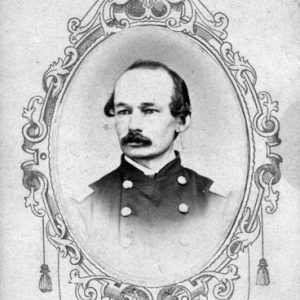calsfoundation@cals.org
Lewisburg, Scouts from (June 1864)
The scouts from Lewisburg (Conway County) were conducted in an effort to locate Confederate troops under Brigadier General Joseph O. Shelby who were recruiting soldiers and attacking Union targets in central and eastern Arkansas during the summer of 1864.
Shelby drove off troops from the Third Arkansas Cavalry (US) and Fourth Arkansas Cavalry (US) garrisoning Dardanelle (Yell County) in the early hours of May 17, 1864, and spent the next two days moving approximately 1,200 Confederate soldiers across the Arkansas River to begin operations behind Federal lines along the river. Union forces struggled to determine the location of the Confederate force and, by late May, had abandoned their bases at Batesville (Independence County) and Jacksonport (Jackson County). Shelby officially took command of all Confederate soldiers north of the Arkansas River on May 31 and set out to bring the bands of irregulars in the region under control by forcing them into the Union or Confederate armies or eliminating them.
Colonel Abraham H. Ryan of the Third Arkansas Cavalry was ordered to consolidate his command at Lewisburg on the Arkansas River on May 30, 1864, and his men would spend the bulk of the next month in scouting expeditions hunting for Shelby and his men.
Major Harry Van Houten led a scouting expedition into Pope and Yell counties in which “he met nothing but bushwhackers,” two of whom his men killed near Dover (Pope County), before returning to Lewisburg on June 5. Ryan’s report noted that Captain Henry Wood and 120 men of the Fourth Arkansas Cavalry were then occupying Dardanelle and that Lieutenant George A. White of the Fourth had mortally wounded a man named “Boss” Dawson and badly wounded another named Banks, “both noted guerrillas.”
Having learned that Confederate colonel Sidney Jackman was near Danville (Yell County) with 200 men, Ryan dispatched Lieutenant Colonel Irving W. Fuller and a detachment of the Third Arkansas into Perry and Yell counties. They returned on June 13, and Ryan reported that the expedition “did not [a]ffect much on account of the enemy scattering in all directions.” Fuller lost one man mortally wounded and captured two Confederates, also bringing in twenty-eight Third Arkansas troopers who had been hiding from guerrillas ever since Shelby captured Dardanelle.
Several other scouting expeditions returned to Lewisburg on June 18. Lieutenant Frederick Williams, who had scouted fifteen miles north of Dover, returned with four men who had been conscripted by Confederate colonel John T. Coffee. Captain Benjamin L. Taylor, who had scouted toward Clarksville (Johnson County), reported that his men had attacked a party of Confederates who had been shooting at a steamboat on the Arkansas River near Galla Rock (Pope County). Lieutenant George P. Carr returned from hunting Shelby in Perry County. Ryan reported that shortly after Carr arrived, twenty-nine men of Shelby’s command were seen on the Arkansas River seven miles below Lewisburg, but they had left by the time Third Arkansas troops arrived.
Major George F. Lovejoy left Lewisburg for Perry County on June 18 with eighty dismounted Third Arkansas troopers. Returning four days later, Lovejoy reported that he and his men had taken a forced march to break up a meeting at a Dr. Hill’s house at which local men were organizing to join Connelly’s band of fifty Confederate irregulars at Danville, but a man named Burroughs, “a citizen who has taken the oath,” warned Hill of their approach. While Lovejoy captured two men, “the rest of the gang escaped.”
Lieutenant Carr set out from Lewisburg on June 20 on a scouting expedition to Pope County that passed through Norristown, Glass Village, and Dover; he left an eleven-man detachment at Dover that encountered a group of twenty bushwhackers “and chased them to the hills, where they escaped.” A four-man detachment from Company D, Third Arkansas Cavalry, killed a pair of guerrillas who had been burning Union boats on the Arkansas River and “captured a so-called Union man who has been in the habit of feeding bushwhackers; also captured 5 horses.”
The June 1864 scouting missions of the Third Arkansas Cavalry did not seriously affect Shelby’s operations north of the Arkansas River, though they did disrupt some of the guerrilla activities in the region. Shelby’s command continued rampaging throughout the summer, sinking the USS Queen City at Clarendon (Monroe County), fighting a force of U.S. Colored Troops at Wallace’s Ferry in Phillips County, and capturing an entire Federal regiment in the August 24 Action at Ashley’s Station before participating in Major General Sterling Price’s doomed raid into Missouri.
For additional information:
Christ, Mark K. “‘The Queen City was a Helpless Wreck’: J. O. Shelby’s Summer of ’64.” In “The Earth Reeled and Trees Trembled”: Civil War Arkansas, 1863–1864. Little Rock: Old State House Museum, 2007.
The War of the Rebellion: A Compilation of the Official Records of the Union and Confederate Armies, Series I, Vol. 34, part 1, p. 1040; part 4, pp. 121, 231, 336–337, 441, 502–503, 517. Washington DC: Government Printing Office, 1891.
Mark K. Christ
Central Arkansas Library System
 Civil War Timeline
Civil War Timeline Military
Military Abraham Ryan
Abraham Ryan 




Comments
No comments on this entry yet.